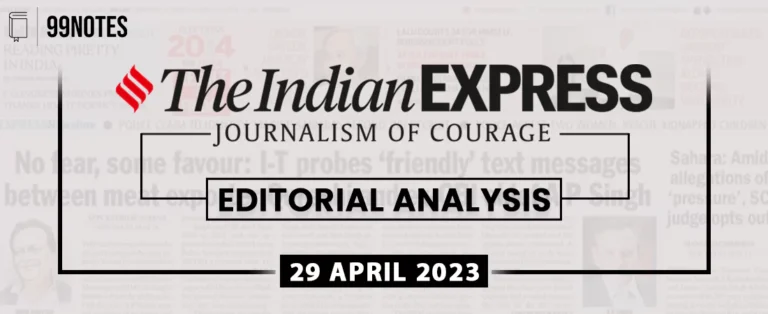8 April 2024 : Indian Express Editorial Analysis
Indian Express Editorial Analysis
8-April-2024
1. Getting around a boycott
|
Topic: GS2 – International Relations – Bilateral Relations This topic is relevant for both Prelims and Mains as the analysis delves into the complexities of bilateral relations between India and Bangladesh, including historical factors, economic ties, and political tensions. |
| Context: |
|
Historical Anti-India Stands:
- From Maulana Abdul Hamid Khan Bhashani to the present-day opposition alliance led by the Bangladesh Nationalist Party (BNP), there have been instances of anti-India stances throughout Bangladesh’s history.
- Bhashani’s pro-China and Islamic socialist views criticized Sheikh Mujibur Rahman’s alignment with India, attempting to forge a coalition against the Awami League.
- The BNP, representing right-of-center forces, has also shown anti-India tendencies, influenced by its orthodox social constituency inspired by Bhashani.
Political Context and Boycott Movement:
- The BNP’s anti-India stance can be seen as an attempt to regain political momentum amidst a decline since 2006.
- Boycotting elections in 2014 and 2024 contributed to a loss of political influence and organizational strength.
- Some BNP leaders, including Ruhul Rizvi and Amir Khasru Mahmud Chowdhury, support the Boycott India movement, aiming to capitalize on public sentiment, despite the party not issuing an official statement.
- This movement includes public displays of rejection of Indian products, symbolized by Rizvi’s public gesture of discarding a Kashmiri shawl.
Economic Prosperity and India-Bangladesh Relations:
- In contrast, Sheikh Hasina’s government has focused on economic development, leading Bangladesh towards middle-income status by 2041 and graduation from the Least Developed Countries list in 2026.
- Economic ties between India and Bangladesh have been crucial for Bangladesh’s prosperity, with India being a major trade partner.
- India’s proximity and established transportation links provide natural trade advantages, facilitating the movement of goods.
- Textiles form a significant portion of India’s exports to Bangladesh, supporting Bangladesh’s garment manufacturing sector, while other imports include petroleum, pharmaceuticals, and machinery.
Infrastructure Development and Trade Partnership:
- India also contributes to Bangladesh’s infrastructure development, supplying construction materials and vehicles.
- Projects like the supply of locomotives and buses have enhanced transportation and efficiency in Bangladesh.
- Additionally, informal trade between the two countries stabilizes inflation and supports economic stability in Bangladesh.
Implications of India Out Campaign:
- The intensification of the India Out campaign threatens to disrupt the existing trade relationship and ongoing negotiations on economic agreements.
- Prime Minister Sheikh Hasina and the ruling Awami League argue against the boycott, emphasizing the importance of maintaining economic ties for both countries’ development.
Youth Perspective and Diplomatic Actions:
- Younger generations in Bangladesh prioritize economic development and are open to collaboration with India.
- Their support for the Awami League-led alliance since 2008 suggests a preference for economic growth over boycotts.
- However, building trust between the governments and promoting people-to-people contact is crucial to sustaining the India-Bangladesh development partnership.
- Measures such as liberalizing the visa regime and sensitizing the media can foster mutual understanding and cooperation.
Conclusion:
- The “India factor” remains a significant aspect of Bangladesh’s domestic politics, characterized by historical tensions and economic interdependence.
- While anti-India sentiments persist, particularly within certain political factions, economic ties continue to drive development and prosperity.
- The challenge lies in balancing political rhetoric with the practical realities of economic cooperation and mutual benefit.
- Both governments must prioritize building trust and cooperation through diplomatic efforts and people-to-people contact to ensure the longevity of the India-Bangladesh partnership.
| What are the Points of Tensions Between India and Bangladesh? |
|
Sharing of Transboundary River Waters:
|
| PYQ: Analyze internal security threats and transborder crimes along Myanmar, Bangladesh and Pakistan borders including Line of Control (LoC). Also discuss the role played by various security forces in this regard. (UPSC CSE (M) GS-3 2020) |
| Practice Question: Analyzing the intricate relationship between Bangladesh and India is crucial for understanding regional geopolitics and economic dynamics. Discuss the historical, political, and economic factors that have shaped this relationship over time. (250 words/15 m) |
2. What women voters want
|
Topic: GS2 – Social Justice – This topic is relevant for both Prelims and Mains as the analysis delves into various social issues affecting women and marginalized communities in India. |
| Context: |
|
More about the news:
Gender Parity Challenges and the Need for Equity:
- Despite some strides, India ranks low on the Global Gender Gap Report, indicating persistent gender disparities.
- The consultative process for a gender manifesto reveals that Indian women demand equity and a dignified life, as enshrined in the Constitution’s preamble.
- Marginalized communities, especially women from historically criminalized tribes and transgender individuals, face challenges such as lack of government identification and identity recognition, highlighting the need for a comprehensive gender agenda.
Recommendations for a Gender Agenda:
- Several recommendations emerge from the gender manifesto, addressing various aspects of gender equality.
- Legislative action is urged to uphold personal rights, including the right to marriage for LGBTQ+ individuals.
- Additionally, addressing safety concerns, especially gender-based violence and online abuse, requires a zero-tolerance policy and reforms in law enforcement.
Social Inclusion and Health Policies:
- Efforts to promote social inclusion involve unlearning gender norms, gender sensitization in education, and shared childcare responsibilities.
- Health policies should prioritize women’s health, including free screenings for breast and cervical cancer.
- Economic empowerment measures, such as funding for women-led startups and policies to enhance women’s participation in the workforce, are essential for women’s economic prosperity.
Political Representation and Reservation:
- While progress has been made with the passage of the Women’s Reservation Bill, implementation remains a challenge.
- The next government must ensure its implementation without delay, along with provisions for reservations for underrepresented communities in legislative bodies.
Conclusion:
- Achieving gender equality in India requires concerted efforts across various domains, including legislation, social norms, healthcare, and economic policies.
- The recommendations outlined in the gender manifesto offer a roadmap for the next government to advance towards a more gender-equal society.
- With the unequivocal will to break new ground, India can shape a future where gender parity is not just an aspiration but a reality.
| What are the Indian Government Initiatives to Promote Gender Equality? |
|
|
| PYQ: Male membership needs to be encouraged in order to make women’s organization free from gender bias. Comment. (200 words/10m) (UPSC CSE (M) GS-1 2013) |
| Practice Question: Discuss the key challenges hindering gender equality in India and suggest policy measures to address them effectively. (150 words/10 m) |
For Enquiry

8 April 2024 : Indian Express Editorial Analysis

6 April 2024 : Daily Current Affairs Quiz

6 April 2024 : Daily Answer Writing

6 April 2024 : Daily Current Affairs

6 April 2024 : PIB Summary for UPSC

6 April 2024 : The Hindu Editorial Notes PDF

6 April 2024 : Indian Express Editorial Analysis

5 April 2024 : Daily Current Affairs Quiz

5 April 2024 : Daily Answer Writing

5 April 2024 : Daily Current Affairs
April 2024 Indian Express 8 April 2024 : Indian Express Editorial Analysis Indian Express Editorial Analysis
6-April-2024
1. Getting around a boycott
Topic: GS2 – International…
Daily Quiz 6 April 2024 : Daily Current Affairs Quiz 6- April 2024 : Daily Quiz…
mains answer writing 6 April 2024 : Daily Answer Writing Mains Answer Writing
6-April-2024
Q1) What makes the India-USA relationship unique is the presence of…
April 2024 Daily Current Affairs 6 April 2024 : Daily Current Affairs Daily Current Affairs
6-April -2024- Top News of the Day
1. India abstains from UNHRC vote that called…
April 2024 PIB 6 April 2024 : PIB Summary for UPSC PIB Summary for UPSC
6-April-2024
1. Hydroelectric power projects with aggregate capacity of 15 GW under…
April 2024 The Hindu Editorial 6 April 2024 : The Hindu Editorial Notes PDF The Hindu EDITORIAL
6-April-2024
1. Parliaments past, a mirror to changing dynamics
Topic: GS2 –…
April 2024 Indian Express 6 April 2024 : Indian Express Editorial Analysis Indian Express Editorial Analysis
6-April-2024
1. Waiting for summer
Topic: GS3 – Indian Economy…
Daily Quiz 5 April 2024 : Daily Current Affairs Quiz 5- April 2024 : Daily Quiz…
mains answer writing 5 April 2024 : Daily Answer Writing Mains Answer Writing
5-April-2024
Q1) The relevance of diaspora as a tool to further the country’s national…
April 2024 Daily Current Affairs 5 April 2024 : Daily Current Affairs Daily Current Affairs
5-April -2024- Top News of the Day
1. Govt. to record parents’ religion to register…


